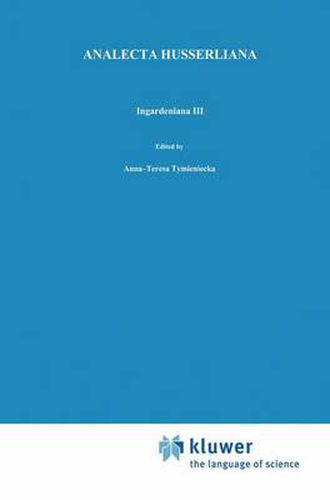Readings Newsletter
Become a Readings Member to make your shopping experience even easier.
Sign in or sign up for free!
You’re not far away from qualifying for FREE standard shipping within Australia
You’ve qualified for FREE standard shipping within Australia
The cart is loading…






This title is printed to order. This book may have been self-published. If so, we cannot guarantee the quality of the content. In the main most books will have gone through the editing process however some may not. We therefore suggest that you be aware of this before ordering this book. If in doubt check either the author or publisher’s details as we are unable to accept any returns unless they are faulty. Please contact us if you have any questions.
In the footsteps of Ingardeniana II, this volume marks the 20th anniver- sary of Roman Ingarden’s death, partly focusing upon his thought, partly bringing his aesthetics into the present-day framework of research. It might have appeared puzzling to the followers of our Analecta Husserliana why within the original horizon encircled by the research work of our International Society of Phenomenology and Literatur- whose research work is devised in a diametrically opposed direction to that of Roman Ingarden - there is steadfastly running through our discussions a line of Ingardenian reflection. The reason, as I have pointed out in the introduction to Ingardeniana II, expertly edited by Hans Rudnik, is clear: Ingarden’s analysis of the intentional structures of works of art offers in its distinct and clear-cut forms an ‘objective’ correlate - as well as a point of reference - to the vast conundrum of issues concerning the creative endeavor of the writer, poet, artist in their struggle to endow life with its specifically human significance; a conundrum that in our research we are trying to disentangl- elucidating its mysterious ramifications, their sources and dynamic virtualities. As a matter of fact, Ingarden’s thought, newly interpreted and originally expanded, occupies a legitimate place in the present collec- tion. We find here, in the first place, an original expansion of Ingarden’s aesthetic theory in the monograph of ladwiga Smith followed by the essays of Wadaw Osadnik, Yushiro Takei and Charles Rzepka.
$9.00 standard shipping within Australia
FREE standard shipping within Australia for orders over $100.00
Express & International shipping calculated at checkout
This title is printed to order. This book may have been self-published. If so, we cannot guarantee the quality of the content. In the main most books will have gone through the editing process however some may not. We therefore suggest that you be aware of this before ordering this book. If in doubt check either the author or publisher’s details as we are unable to accept any returns unless they are faulty. Please contact us if you have any questions.
In the footsteps of Ingardeniana II, this volume marks the 20th anniver- sary of Roman Ingarden’s death, partly focusing upon his thought, partly bringing his aesthetics into the present-day framework of research. It might have appeared puzzling to the followers of our Analecta Husserliana why within the original horizon encircled by the research work of our International Society of Phenomenology and Literatur- whose research work is devised in a diametrically opposed direction to that of Roman Ingarden - there is steadfastly running through our discussions a line of Ingardenian reflection. The reason, as I have pointed out in the introduction to Ingardeniana II, expertly edited by Hans Rudnik, is clear: Ingarden’s analysis of the intentional structures of works of art offers in its distinct and clear-cut forms an ‘objective’ correlate - as well as a point of reference - to the vast conundrum of issues concerning the creative endeavor of the writer, poet, artist in their struggle to endow life with its specifically human significance; a conundrum that in our research we are trying to disentangl- elucidating its mysterious ramifications, their sources and dynamic virtualities. As a matter of fact, Ingarden’s thought, newly interpreted and originally expanded, occupies a legitimate place in the present collec- tion. We find here, in the first place, an original expansion of Ingarden’s aesthetic theory in the monograph of ladwiga Smith followed by the essays of Wadaw Osadnik, Yushiro Takei and Charles Rzepka.